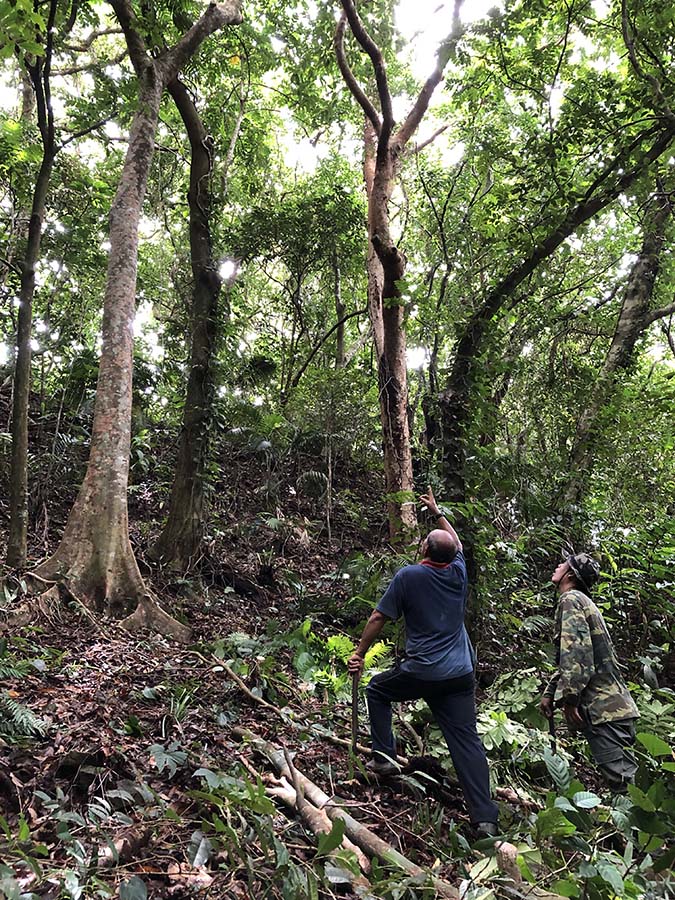"Tatala" – Small Boat
The wish to build a traditional plank boat, with all the knowledge, skill, and hard work this entails, is challenged by what money can buy in the age of fast motorboats. But these are not equivalents. Building a Tau boat, one’s own or a shared boat, is a source of joy and esteem for a Tau man. The boathouses protect these assemblages of wealth, allowing them to live longer, to catch more fish, and to save more trees.
When I was a child, I used to go to the beach to participate in the annual Summoning of the Flying Fish festival. At that time, each family had their own lashed-lug plank boat or tatala, a small vessel for one or two scullers, used primarily in nearshore waters. Families would sit next to their boat at the ceremony. I still have vivid memories of standing in the boat that my grandfather built a long time ago, listening to the elders conversing about the ocean’s appearance.
Since then, purchase of imported modern boats came to replace the more laborious choice of making traditional plank boats, whose numbers on the beaches declined. Motor boats are fast and convenient. During the flying fish season, you start the engine, turn the steering wheel, and very quickly you are at the fishing grounds, with capacity for a sizeable catch. Traditional plank boats require paddling to reach the fishing ground, which is much more effort. Moreover, the volume of catch is more limited. From an economic point of view, the traditional lashed-lug plank boat does not give much benefit or make much ‘rational’ sense.

Fig. 2: Father and son study
trees to be cut for the tatala.
And yet, there are some good reasons to embark on the long and complicated process of building a traditional Tau fishing boat. For one, you get to know your family’s land in the mountain forest. Only then can you cut down the trees needed for the boat. Each plank needs to be carved out from specific parts of certain trees and carried down the mountain, a part of the process that makes you feel utterly exhausted. Then the planks and wooden pieces are assembled into a boat, and the boat is decorated with engraved totems. Each of the numerous steps in the process requires knowledge and skill, which one acquires along the way, as in an apprenticeship. Unengraved boats do not call for a special boat launch ceremony. But if you engrave totems on your boat, you need to prepare for a large festive ceremony, including gifting plenty of taro and pork to family and friends.
This long and tedious project makes some Tau men hesitate. If you want to make a boat, you need an abundance of determination and endurance to complete it. But the entire process is inherently, deeply rewarding.
Nowadays, Indigenous people are more willing to invest time and money in tourism to make money. To raise a family, buy daily necessities, and pay for all kinds of expenses, you need money. The number of people willing to go up the mountain to chop down trees, carve out planks, and make a boat is getting smaller and smaller.

Fig. 3: Preparing to go out fishing.
When I returned from Taiwan, where I worked and studied, to Pongso no Tau in 2016, my grandfather’s and father’s boats had become worn out. So when I participated in the Summoning of the Flying Fish ceremony, I joined a team of ten rowers in a large boat – cinedkheran, which is similar in design to the tatala, but much larger, for use farther out at sea – for the common ritual of the kin group. Before long, I began to wish for my own boat so that our family would have a place to gather on the vanuwa (beach).
When I talked with my parents, they told me that we needed to spend much time and effort to prepare for it. In 2019 I went into the mountains together with my father to search for suitable trees for the various planks, and in 2020 we started to chop down trees and carve out planks for the boat. Most of the wooden boards were carried down the hill on my shoulders and the shoulders of my father and another friend. It was very heavy and exhausting, but down we went!
Fig. 4: A nicely decorated tatala.
Once we carried a wooden plank down the mountain, we would continue to carve it out. After we finished roughly 80 percent, careful not to carve away too much, we went back up the mountain to chop and carve another plank. A tatala requires 15 boards and a number of other wooden parts. After assembling the boat, we brought it home to engrave, which entails preparing for a boat launch ritual. My father would surely give blessings to me and the boat, for this was my first boat. It was my father who introduced me to the forest on the mountain and helped me build the boat. This was the mission my grandfather had entrusted to my father, a mission he had hereby completed.
Thirty years ago, this patch of ocean was filled with plank boats catching flying fish. Sadly, we are now only a few who fish from plank boats. But I rejoice in the happiness this brings! I want to keep going until I cannot push the boat anymore.
Si Rapongan lives in Imourud. He currently serves as Yami representative in the Council of Indigenous Peoples. At age 12, he left his island to study in Taiwan. At age 26, while working at the Taiwan Indigenous Library and Information Center in Taipei, he came to realise the depth of his cultural heritage. Several years later, he returned to his home island to immerse himself in Tau knowledge and practice. In 2020, he built a two-man boat together with his father. Email: klin19867597@gmail.com